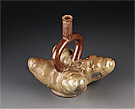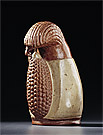Curriculum links Design/Tech
Food production: Focus on the Moche culture
The Moche depicted everyday items in clay pots including foods such as maize, beans, yucca, squash, potato, peanuts and locally grown gourds. The Moche farmed domesticated varieties of these plants, even on the arid coast where agriculture was made possible by irrigation from mountain water sources. The rivers’ relatively low water volume and erratic nature still makes irrigation a challenge for highlanders and lowlanders. The river arrangement isolated and regionalised early coastal cultures into units living in adjacent valleys. In later times, especially through large hydraulic (water powered) projects, the Nazca, Moche and Chimú were able to unify increasingly large coastal territories.
Food production
- Maize (Zea mays) was one of the most commonly depicted foodstuffs in Andean art. How can the objects depicting maize in the Gold and the Incas exhibition tell us more about the importance of corn in the Andean diet?
- Investigate how the development of irrigation in the ancient Peru was constantly refined with various cultures before the large enterprises of the Moche and Chimú.
- Research the role of chicha in Andean cultures by viewing works of art in the Gold and the Incas exhibition that refer to the manufacture, storage and use of this commodity.
- Potatoes belong to the single species, Solanum tuberosum and are known for their diverse genetic variation. Discover the features of potato production that led to the vegetable becoming such an important commodity in the highlands of Peru by reading the Gold and the Incas catalogue entry for the Moche potato vessel.
- Research the foods and recipes advocated by the Peruvian chef, Gastón Acurio Jaramillo. How do his ingredients and approach compare with the foods that are represented in various media in the Gold and the Incas exhibition?
Fishing
- Why were fish so important in the diet of ancient Peruvian peoples? Identify three objects in the Gold and the Incas exhibition that confirm the importance of the sea in Andean culture.
- Who was Alexander von Humboldt and why was his name given to the current that created such rich fishing grounds off the coast of Peru? How did the current affect the diet of ancient Andean peoples in coastal and inland cultures?
- Research Peru’s fishing industry today and determine if the industry is a sustainable concern.
Pottery
- Examine the Moche pots in the Gold and the Incas exhibition. How do these objects communicate information about Moche society given that written communication was not practised?
- Research the role of pottery in the cultural life of the Moche. Why were their pottery workshops so large and production rates so prolific?
- Investigate the circulatory characteristics and symbolism of the stirrup-handled Moche vessels by reading a number of catalogue entries and evaluate their practical advantages.
- Design and produce a food storage container for fish, potatoes or corn that would prevent varying temperature ranges from spoiling foodstuffs. Think about the importance of trade between Andean societies to help you consider the time taken for food stuffs to travel from production areas to their destination. Do any foods require further preservation processes before being transported? Explain the benefits and features of your design.
- Design implements for a Moche ceramic workshop that would enable potters to create smooth and symmetrical surfaces on the outside of the pot. Use the catalogue entries about ceramics in the Gold and the Incas exhibition to help you understand how the Moche achieved sophisticated production techniques in their workshops without the potter’s wheel.
- Investigate the river systems and sea level changes in the Andean peninsula and design an irrigation system that harnesses the water resources of two adjacent rivers for food production. Use sketching and orthogonal drawings to develop your design. Produce a model of your irrigation system—work individually or in groups and choose different areas of the costa. Evaluate the advantages and disadvantages of your design and indicate the most suitable crops for your chosen area.
- Design a Moche building taking into account religious, political and processional requirements, orientation, materials, ritual platforms, food storage areas, patios, workshops and temperature considerations. Include areas for the state-pottery and textile workshops. Design murals for the interiors that reflect cultural motifs that you have researched in the Gold and the Incas exhibition.







